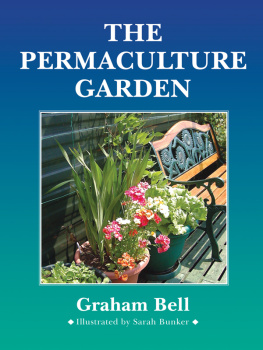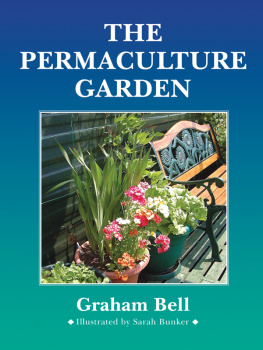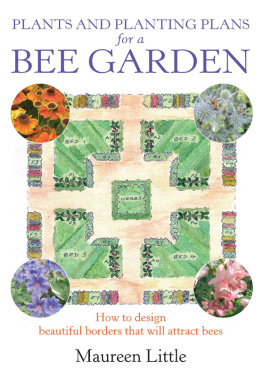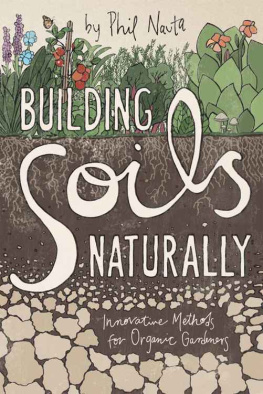
The Permaculture
Garden
Graham Bell
Illustrated by Sarah Bunker
CHELSEA GREEN PUBLISHING COMPANY
White River Junction, Vermont
A Permanent Publications Book
For Nancy and the
Glory of the Garden
Published by:
Permanent Publications
Hyden House Ltd.
The Sustainability Centre
East Meon
Hampshire
GU32 1HR
UK
Tel: (01730) 823 311
Fax: (01730) 823 322
Email: enquiries@permaculture.co.uk
Web: www.permaculture.co.uk
Published in the United States in 2005
by Chelsea Green Publishing Company
www.chelseagreen.com
Published in 2004
by Permanent Publications, UK
First Published 1994
by Thorsons an imprint of Harper Collins
1994 Graham Bell
Illustrations by Sarah Bunker
Cover photograph by Aranya
British Library Cataloguing in-Publication Data
A catalogue record for this book is available from the British Library
eBook ISBN: 978-1-60358-128-8
All rights reserved. Apart from any fair dealing for the purpose of study, research, criticism or review, as permitted under the Copyright Act, no part of this publication may be reproduced, stored in a retrieval system, rebound or transmitted in any form or by any means, electronic, mechanical, photocopying, recording or otherwise, without the prior written permission of Graham Bell, Hyden House Limited or Chelsea Green Publishing Company.
Contents
I would like to thank the following gardeners for inspiration from their plots:
Eoin Cox, Jedburgh
Kate Cox, Holefield
Rod and Jane Everett, Middlewood
Phil and Anne Harris, Heatherslaw
Robert Hart, Rushbury
Ken Fern and all at Lower Penpol
John Manson, Greenlaw
Steve and Yvonne Page, Chez Forest
Emma and Bernard Planterose, Scourie
Clive Simms, Essendine
Owen Smith and Jill Jackson, Tai Madog
Tony Wrench, Wales
My apologies to the many more to whom I could have acknowledged my due debt.
I would like to thank the following co-teachers of Permaculture for what I have learned from them:
Chris Dixon, Sylvia Eagle, Patsy Garrard, Lea Harrison, Jane Hera, Joanna Jackson, Andy Langford, Ian Lillington, Bill Mollison, Stephen Nutt, Simon Pratt, George Sobol, Charlie Wannop, Patrick Whitefield.
In addition this work would not have been possible without the kind and loving support of Bob Clarke, Martin Hadshar, Steve Hoyle, Bruce Lowe, Julian Watson, Sandy Watson, Nancy Woodhead, Diana and Jay Woodhead.
Key to symbols used within the tables:
A Annual
P Perennial
B Biennial
TP Perennialbut tender
HH Half-Hardy Annual
For more information on usage of individual plants, see my previous book The Permaculture Way (Thorsons, 1992).
All that matters is to be at one with the living God
To be a creature in the house of the God of Life
D.H. LAWRENCE (1885-1930), 'PAX'
I love gardens. When gardening, or just being in a garden, I feel truly alive, as if the garden connects me to a deep nourishing source of energy. Gardens remain a positive and vibrant joy in the centre of the lives of many people struggling to understand and cope with a pretty stressful and possibly crazy world.
This book is aimed at anyone with whom these thoughts resonate and is intended to encourage the many people who would like more out of their gardens, but find that they have limited time. It offers some approaches to gardening shared by those with a deep commitment to regeneration of both the Earth and the human spirit. 'Green' is one symbolic word used to describe this outlook. I'm not sure the label is too helpful, but it is an appropriate word to describe the levels of abundance you will achieve in your garden if you follow the advice contained within these pages.
When we spend time in the garden we are re-connecting ourselves to the living processes of the planet Earth, our home. Gardening is active leisure: not a 'pass-time' activity, but a creative enriching experience. Foolishly, we talk about 'being outside', as if the house were our 'real' place in the world, rather than the open air.
This sense of disconnection is a direct result of a series of revolutions; agricultural, industrial, and most recently, that of information technology. Before these changes tore society apart the majority of people passed the majority of their time with a direct connection to and a keen interest in their natural environment.
This book proposes another way of gardening, one which re-establishes our sense of belonging to the world, of being an intimate part of the living cosmos, rather than separate from it. It doesn't suppose that we're all 'going back to nature' (we never left it), or even that we have to give up our day jobs. Nor does it propose a lot of hard work. It does reveal a way in which ordinary people can do their bit to re-green the planet.
Large sentiments for so humble a pursuit as gardening, perhaps. Yet we stand at a crucial time of choice in human affairs. Either we continue to regard our powers of control over nature as infinite, and the Earth a bottomless well of resources for our consumption, or we face up to the degradation of environment and human soul which is globally evident, and decide to accept responsibility. In the face of impending global disaster most of us feel overwhelmedbut our back yards offer us an immediate avenue for practical planet care.
Good-quality land is increasingly scarce. World population is growing. Oil is running out. We could take these as a doom-and-gloom scenario, or, if you take my tip, you'll garden. Growing your own food, making tiny part-acres into vibrant mini-forests, is a direct and positive reaction to set things right.
In Kerala in India (a state jam full of gardens), a half-acre is seen as a farm which should feed a family. The average back garden may be smaller than this, but can still be highly productive, and in doing so take no more than an hour or two a week by using design methods which minimize effort.
When we garden we make contact through all our senses with the vagaries of weather, the changing moods and demands of the seasons, even the relative movements of the stars and the phases of the moon. In so doing we re-develop within ourselves an understanding of the quality of the fertile processes which make our gardens abundant, and feel ourselves again as part of the continuum of life, rather than separate observers.
This process of designing our lives from observations of nature based on seeing ourselves as part of nature has been called Permaculture, derived from the words Permanent Agriculture , but also implying permanent culture. My previous book, The Permaculture Way (Thorsons 1992) provides an introduction to that design methodology in general terms. In this book we examine specifically how Permaculture can be applied in gardening. Later in this introduction we shall look at the whole question of culture, and how strongly gardening features in our cultural inheritance.
A short answer would be that it is the art of the possible. Environmentalism was brought to public attention in the 1960s around 'conservation' issues. Permaculture seeks to go beyond that to regenerative policies which will restore global environments over time in a living changing way, rather than simply halting the further destruction of small parts of the planet, and preserving them as museum pieces. From small beginnings it has become a major body of knowledge about how to design the places where people live and work.













